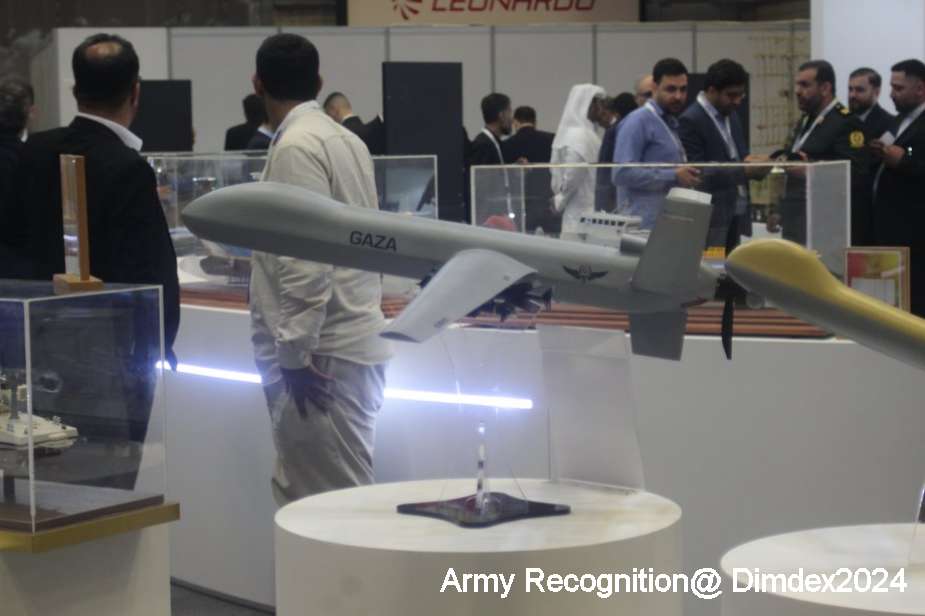Breaking news
Iran unveils Shahed-149 Gaza combat drone for first time at DIMDEX 2024.
At the DIMDEX 2024 expo, currently being held from March 4th to 6th, with Army Recognition as the official media partner, Iran marked a noticeable presence among defense exhibitors in the Middle East. With a substantial stand in Qatar, Iran showcased a wide array of armaments, including the Shahed-149 Gaza drone. This unmanned aerial vehicle, first unveiled in 2021, stands out among the innovations presented, highlighting Iran's technological advancement and armament production capability.
Follow Army Recognition on Google News at this link

Iran Shahed-149 Gaza Unmanned Aerial Vehicle (Picture source: Army Recognition)
The Shahed 149 Gaza, an Iranian combat drone operated by the Iranian Revolutionary Guard, was officially introduced on May 21, 2021, and delivered to the Islamic Revolutionary Guard Corps Aerospace Force in 2022. Comparable in size and function to the American MQ-9 Reaper, this UAV is classified as a high-altitude, long-endurance vehicle, developed from the Shahed 129. It has a wingspan of 21 meters, a length of 10 meters, and a height of 4 meters. The basic UAV weight, with fuel tanks empty, is 1740 kg, with a takeoff weight of 3740 kg. Its maximum fuel capacity is 1500 kg, with a payload weight of 500 kg. The Gaza is powered by a turboprop engine with 750 horsepower, achieving a maximum speed of 350 km/h and a cruise speed of 215 km/h. It has a maximum flight endurance of 25 hours and can reach a height of 35,000 feet.
In terms of armament capabilities, the Shahed 149 Gaza can carry 13 bombs and up to 500 kg of electronic equipment, thanks to an internal atrium and a rotating arm release device.
The drone was first mentioned on Twitter by a defense reporter for Tasnim News on February 23, 2020. Its official unveiling occurred in May 2021, and it completed its flight tests in April 2022 before being accepted for service.
The Gaza drone's avionics suite includes electro-optical/infrared sensors, a day-vision camera with significant zoom capabilities, a thermal imager camera, a laser rangefinder, and environmental monitoring within a 500 km radius. It would have the capability to detect stealth aircraft up to a 500 km radius and would be equipped with a satellite communication antenna.
Iran has heavily invested in military research and development over the decades, with a particular focus on technologies such as drones to address shortcomings in its air force. This emphasis on drones has increased over time, particularly after the Iran-Iraq war in the 1980s, which highlighted the need to preserve limited human and material resources.
Another crucial factor is Iran's ability to leverage its expertise in reverse engineering. By studying and acquiring foreign drones, especially those captured or shot down, Iranian scientists and engineers have been able to develop their technology and produce domestic drones.
Moreover, Iran has successfully established strategic partnerships and smuggling networks to obtain parts and technologies necessary for drone production, bypassing international sanctions and enhancing its self-sufficiency in this field.
The effectiveness of these drones has been demonstrated not only in operations within Iran but also in Russia. They have been deployed in Russia and played a crucial role on the battlefield. This has not only allowed Iran to test its capabilities in a dynamic environment but also to showcase the effectiveness of its drones to potential partners.
Finally, drones have been used by Iran as a diplomatic tool to strengthen regional and international alliances, notably with Russia. This approach has enabled Iran to develop its relations with countries sharing similar security concerns and to explore new opportunities for drone exports.























